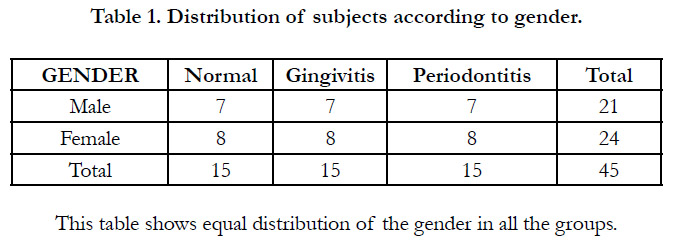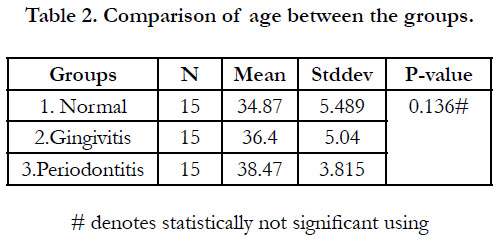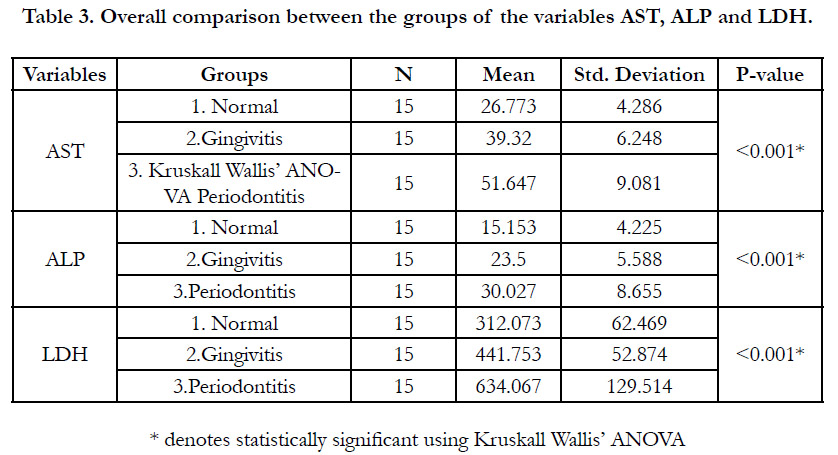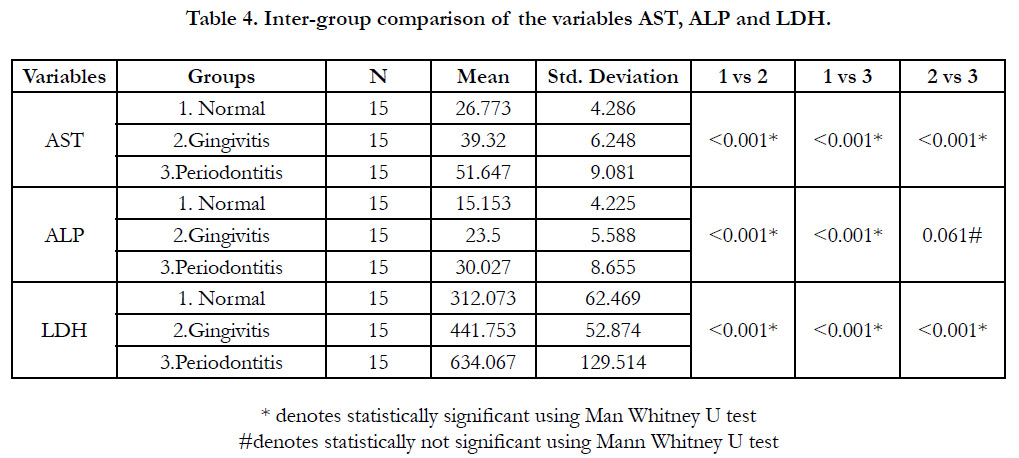Comparison of Lactate Dehydrogenase (LDH), Aspartate Aminotransferase (AST) and Alkaline Phosphatase (ALP) in Saliva of Normal, Gingivitis and Periodontitis Patients
Santhosh Kumar Caliaperoumal*, Harish Gnanasekaran, Sriram Kaliamoorthy
Department of Dentistry, Vinayaka Missions Medical College,Vinayaka Mission's Research Foundation (Deemed to be University), Karaikal – 609 609, Puducherry, India.
*Corresponding Author
Santhosh Kumar Caliaperoumal,
Professor and Head of Department, Department of Dentistry, Vinayaka Missions Medical College,Vinayaka Mission's Research Foundation (Deemed to be University), Karaikal
– 609 609, Puducherry, India.
E-mail: sanjosh80@gmail.com
Received: June 26, 2021; Accepted: November 17, 2021; Published: November 29, 2021
Citation: Santhosh Kumar Caliaperoumal, Harish Gnanasekaran, Sriram kaliamoorthy. Comparison of Lactate Dehydrogenase (LDH), Aspartate Aminotransferase (AST) and
Alkaline Phosphatase (ALP) in Saliva of Normal, Gingivitis and Periodontitis Patients. Int J Dentistry Oral Sci. 2021;8(11):5164-5167. doi: dx.doi.org/10.19070/2377-8075-210001037
Copyright: Santhosh Kumar Caliaperoumal©2021. This is an open-access article distributed under the terms of the Creative Commons Attribution License, which permits unrestricted use, distribution and reproduction in any medium, provided the original author and source are credited.
Abstract
Introdction: Gingival and periodontal diseases are one of the most common oral diseases. It is a chronic, infectious, and
multi-factorial disease which results in inflammation and destruction of the supporting tissues of the teeth, progressive attachment
loss and bone loss. Chronic periodontitis can lead to tooth mobility, tooth loss and systemic complications. Recently,
several salivary biomarkers of periodontal disease were being evaluated for disease activity status. The current study was
undertaken to compare the level of salivary Lactate dehydrogenase (LDH), Aspartate aminotransferase (AST) and alkaline
phosphatase (ALP) in normal, gingivitis and periodontitis patients.
Material & Methods: The totals of 45 subjects were included in the study. They were divided into three groups with 15
subjects of Normal, Gingivitis and Periodontitis patients. The saliva samples were collected and the Lactate Dehydrogenase
(LDH), Aspartate Aminotransferase (ASP) and Alkaline Phosphatse (ALP) levels were measured using commercially available
kits using auto-analyzer according to the manufacturer’s instructions. The results obtained were statistically analyzed by multiple
inter-group comparisons using SPSS software by using ANOVA and Scheffe multiple comparisons.
Results: The results of Kruskall Wallis’ ANOVA showed all the three variables AST, ALP and LDH had statistically significant
differences, with periodontitis patients showing the highest value for AST, ALP and LDH. The Mann Whitney U test
showed that all the three variables SGOT, ALP and LDH had statistically significant difference between groups, except for
ALP between gingivitis and periodontitis patients were not statistically significant.
Conclusions: The results led to a conclusion that the all the three variables AST, ALP and LDH were good markers to differentiate
the normal, gingivitis and periodontitis patients except for ALP which was not significant between gingivitis and
periodontitis patients.
2.Introduction
3.Materials and Methods
3.Results
4.Discussion
5.Conclusion
5.References
Keywords
Aspartate Aminotransferase; Alkaline Phosphatase; Lactate Dehdrogenase; Periodontitis; Gingivitis.
Introduction
Gingival and periodontal diseases are one of the most common
oral diseases. It is a chronic, infectious, and multi-factorial disease.
It is caused by an interaction of dental plaque, dental calculi
and their microbial invasion and interactions in periodontium and
host immunological responses. The gingivitis and periodontitis
result in inflammation and destruction of the supporting tissues
of the teeth, progressive attachment loss and bone loss [1].
Chronic periodontitis can lead to tooth mobility, tooth loss and
systemic complications. There have been reported association
between systemic disorders like diabetes mellitus, dermatological
disorders, birth complications (low birth weight and pre-term
birth), coronary heart disease, atherosclerosis, infective endocarditits,
rheumatic arthritis, pneumonia, osteoporosis, oral cancer
and other disorders [2].
The conventional diagnosis of periodontal disease is determined
through clinical measurements such as probing pocket depth,
bleeding during probing, clinical attachment loss, plaque index,
and radiographs. The disadvantages of these conventional methods
of diagnosis include the need for skilled clinicians and significant
time, and the inability to diagnose present disease activity
[3, 4].
In recent years, several salivary biomarkers of periodontal disease
have been introduced [5, 6]. Among the salivary biomarkers,
Lactate dehydrogenase (LDH), Aspartate aminotransferase (AST)
and alkaline phospahatase (ALP) are associated with tissue destruction,
bone resorption and inflammations of periodontal disease
[7-9]. They are considered to be ideal markers of periodontal
disease activity [10, 11].
With this background the present study was done to compare the
level of salivary Lactate dehydrogenase (LDH), Aspartate aminotransferase
(AST) and alkaline phospahatase (ALP) in normal,
gingivitis and periodontitis patients.
The aim of this study was to compare the LDH, AST and ALP
levels in normal, gingivitis and periodontitis patients and to identify
most specific marker or combination of markers in differentiating
the normal and disease status.
Materials And Methods
The study was undertaken in department of dentistry, Vinayaka
mission’s medical college and hospital. The Institutional ethical
committee approval and Informed consent was obtained before
proceeding with the study. The healthy patients aged between 20
to 70 years with minimum 20 teeth were included for study.
The patient with systemic diseases, antibiotic or anti-inflammatory
drug therapy in previous 3 months, periodontal treatment
within past 6 months, alcohol, tobacco or drug abuse, any abnormal
oral inflammation or local oral ulcer and pregnant women
were excluded from the study.
A total of 45 subjects were subjected to experiment and they were
divided into three groups.
1. Group 1 (n=15): The periodontally healthy subjects with absence
of gingival inflammation, no bleeding on probing, no probing
depth (PD) > 3 mm and no attachment level < 2mm.
2. Group 2 (n=15): The subjects suffering from chronic generalized
gingivitis without clinical attachment loss. The subjects with
gingival inflammation, bleeding on probing, no probing depth
(PD) > 3 mm, and no attachment level > 2mm.
3. Group 3 (n=15): The subjects suffering from chronic generalized
periodontitis. The subjects should have at least eight sites
with PD > 4 mm and attachment level > 2 mm.
Saliva Sampling
The collection un-stimulated whole saliva sample from the test
and control groups was done with strict protocol. Patients were
asked to avoid eating or drinking for at least two hours prior to
saliva collection. The samples were obtained between 9:00 AM
and 12:00 PM. Before sampling, patients were given oral irrigation
with water for one minute. Their oral cavity was examined
to ensure the absence of blood and debris. About 3ml of saliva
was collected in a sterile micro-tube and kept at 4°C. Laboratory
analysis of each saliva sample was done on the day of collection in
biochemistry lab. The Lactate Dehydrogenase (LDH), Aspartate
Aminotransferase (ASP) and Alkaline Phosphatse (ALP) levels
were measured using commercially available kits using auto-analyzer
according to the manufacturer’s instructions.
The results obtained were statistically analyzed by multiple intergroup
comparisons using SPSS software by using ANOVA and
Scheffe multiple comparisons. (P < 0.001).
Results
In our study, there were 7 males and 8 females in each group (Table
1) which shows similar gender distribution.
The mean age of group 1 normal subjects was 34.87+/- 5.489
years, group 2 gingivitis patents was 36.40 +/- 5.040 years and
group 3 periodontitis patients was 38.47 +/- 3.815 years (Table 2).
On comparison of mean age between group 1, group 2 and group
3 there was no statistically significant variation indicating that the
groups were age matched.
In Table 3, the mean AST level in Group 1 was 26.773+/-4.286,
group 2 was 39.320+/-6.248 and group 3 was 51.647+/- 9.081.
On comparing AST level between groups, the values were statistically
significant (P< 0.001) by using Kruskall Wallis’ ANOVA.
The mean ALP Level in Group 1 was 15.153+/-4.225, group
2 was 23.5+/-5.588 and group 3 was 30.027+/-8.655 with statistically significant difference (P<0.001) on comparison. The
mean LDH level in Group1 was 312.073+/-62.469, group 2 was
441.753+/-52.874 and group 3 was 634.067+/-129.514. The statistical
comparison of LDH level between these groups were significant
(P <0.001).
The Table 4 revealsInter-group comparison of the variables AST,
ALP and LDH level by Man Whitney U test. It shows that all the
three variables SGOT, ALP and LDH have statistically significant
difference (P< 0.001) between groups, except for ALP where difference
between Gingivitis and Periodontitis was not statistically
significant.
Discussion
Gingivitis and periodontitis are one of the most common, chronic,
infectious and multi-factorial oral diseases resulting in inflammation
and destruction of the supporting tissues of the teeth,
progressive attachment loss, bone loss, teeth mobility and its loss
[1, 2]. In recent years, several salivary biomarkers are being studied
for diagnosis. Assessment the salivary biomarkers level have
advantages as it is simple, time saving and reduces the need for
skilled personal3. It also helps in monitoring treatment prognosis
and evaluation of ongoing disease activity.
In the present study we compared and evaluated the level of salivary
aspartate aminotranferase (AST), alkaline phosphatase (ALP)
and lactate dehydrogenase (LDH) in normal, gingivitis and periodontitis
patients. There was a statistical significant difference in
level of AST, ALP and LDH between all the groups by Kruskall
Wallis’ ANOVA test. The inter-group comparison by Man Whitney
U test revealed statistical significant difference between each
group with levels of AST, ALP and LDH except between group
2 and group 3 with level of ALP.
Yoshiaki Nomura et al [11] in 2006 studied various salivary enzymes
in normal and periodontitis patients and found out that
there was a statistical significant difference in LDH followed by
AST, there was no statistical significance with ALP. TodorovicTatana
et al [6] in a similar study reported a significant difference in
level of LDH, AST and ALP between normal and periodontitis
patients before and after treatment.
In 2006 Totan A et al [9] observed a significant difference in level
of AST and ALP between normal and periodontitits patients.
Deepika V et al [4] in casual observation found that increased
AST and ALP levels between normal and periodontitis patients.
Kudvaet al10 in 2014 found significant difference in the level of
AST between gingivitis and periodontitis patients before and after
treatment. Desai S et al [3] reported a significant level of ALP in normal and chronic periodontitis patients.
Janet Moradi Haghgoo et al[7] observed significant level of LDH
difference among normal and periodontitis patients. Havleet al8
reported a significant level of difference in LDH among normal
and periodontitis in pre and post treatment patients.
The present study yielded similar results compared to previous
studies [3-11] which involved either single or multiple biochemical
parameters in mostly normal and periodontitis patients. It differed
from other studies in inclusion of gingivitis patient group
and in differentiating the gingivitis and periodontitis patients with
ALP level. The difference in ALP levels may be due to the fact
that there was no comparison made between gingivitis and periodontitis
in previous studies. The ALP may be the initial marker
to be raised in gingivitis and may remain constant as disease progresses.
The level of LDH was comparatively higher in periodontitis
group than other markers; it may reflect the underlying tissue
damage better than others.
So, in this study the salivary level of LDH, AST and ALP were
significant in differentiating the normal versus gingivitis versus
periodontitis patients, except in ALP with gingivitis versus periodontitis
patients.
Conclusion
Within the limitations of this study, we could conclude that the
salivary AST, ALP and LDH level may be used as an adjuvant
diagnostic method to differentiate the normal, gingivitis and periodontitis
patients. This could be used in mass screening and home
based self-diagnostic indicator which has to be followed by clinical
diagnosis. Further studies are needed to evaluate the role of
these biochemical markers in assessing the gingival and periodontal
health status.
Acknowledgement
The completed research was approved and certified by ICMR.
References
-
[1]. Kim J, Amar S. Periodontal disease and systemic conditions. A bidirectional
relationship. Odontology. 2006; 94(1): 10-21.
[2]. Weidlich P, Cimőes R, Pannuti CM, Oppermann RV. Association between periodontal diseases and systemic diseases. Braz Oral Res. 2008; 22(spec iss 1):32-43.
[3]. S Desai, H Shinde, J Mudda, V Patil. Levels of Alkaline Phosphatase (ALP) In Saliva of Patients with Chronic Periodontitis; a Clinical and Biochemical Study. The Internet Journal of Dental Science. 2008; 8(1): 1-7.
[4]. Deepika. V, Vishnu Priya. V, AroonikaBedre, Harsha. L. Salivary AST, ALP and CK Levels in Patients with Periodontitis. J Pharm. Sci. & Res. 2015; 7(6): 341-343.
[5]. Toba Jr M, Kinney J, Kim AS, Giannobile WV. Diagnostic Biomarkers for Oral and Periodontal Diseases. Dent Clin N Am. 2005; 49(3): 551-71.
[6]. Todorovic T, Dozic I, Vicente-Barrero M, Ljuskovic B, Pejovic J, Marjanovic M, et al. Salivary enzymes and periodontal disease. Med Oral Patol Oral Cir Bucal. 2006; 11(2): E115-9.Pubmed PMID:16505786.
[7]. Janet MoradiHaghgoo, Sara Soheilifar, Mohsen Bidgoli, NedaRastegarfard, MaralSaremi, and SamareKafilzade. Comparison of Whole Salivary Lactate Dehydrogenase Level in Patients With and Without Periodontal Disease. Avicenna J Dent Res. 2016; 8(4): e27208. 1-6.
[8]. Abhinav AvinashHavle , GirishSuragimath, Sameer A.Zope, Siddhartha A. Varma, Ashwinirani SR, KimayaAvinashHavle. Comparison and correlation of lactate dehydrogenase levels of saliva and serum in healthy subjects, patients with gingivitis and chronic periodontitis. International Journal of Current Research. 2017; 9 (6): 53190-53193.
[9]. Totan A, Greabu M, Totan C, Spinu T. Salivary aspartate aminotransferase, alanine aminotransferase and alkaline phosphatise: possible markers in periodontal diseases? ClinChem Lab Med. 2006; 44(5): 612-5.Pubmed PMID: 16681433.
[10]. Kudva P, Saini N, Kudya H, Saini V.To estimate salivary aspartate aminotransferase levels in chronic gingivitis and chronic periodontitis prior and following non – surgical periodontal therapy: A clinic-biochemical study. J Indian SocPeriodontol. 2014; 18(1):53-8.Pubmed PMID: 24744545.
[11]. Nomura Y, Tamaki Y, Tanaka T, Arakawa H, Tsurumoto A, KirimuraK,et al. Screening of periodontitis with salivary enzyme tests. J Oral Sci.2006;48(4):177–83.Pubmed PMID:17220614.









